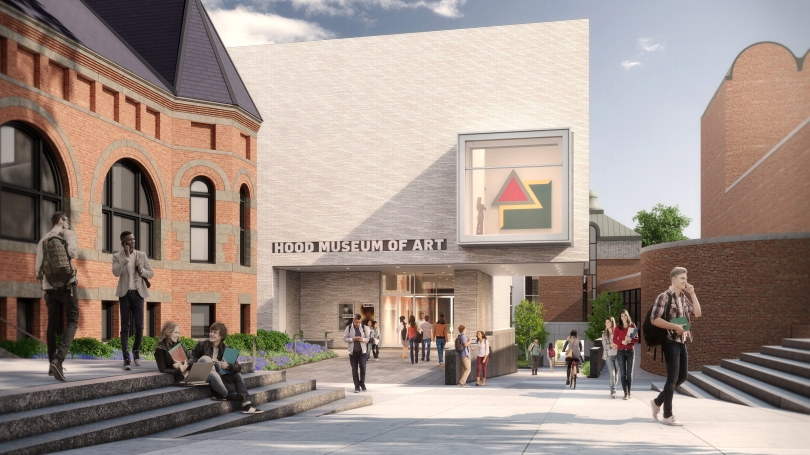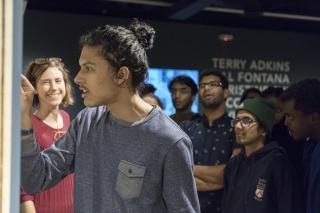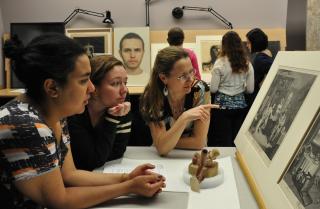
LEFT Artist rendering of the north façade of the expanded Hood Museum of Art. Rendering by MARCH.


ABOVE Three new smart object-study rooms in the museum’s new Center for Object Study will create unparalleled opportunities for study and research in a museum setting, addressing the increased curricular demand for direct engagement with original works.
Dartmouth’s collections are among the oldest and largest of any college or university in the country, but it was not until the Charles Moore–designed Hood Museum of Art opened its doors in 1985 that they were all housed under one roof and made available to faculty, students, and the public. When first accredited in 1990, the Hood was already described by the American Association of Museums (now the American Alliance of Museums) as a “national model” for college and university museums. The museum has been consistently accredited since then and subsequently labeled “as fine a museum as one can find in this country.” The Hood’s collections are drawn from a broad range of cultures and historical periods and represent a remarkable educational asset for both Dartmouth and its regional communities. Among the museum’s most important holdings are six Assyrian stone reliefs from the palace of Ashurnasirpal II (about 900 BCE) and the remarkable fresco by José Clemente Orozco titled The Epic of American Civilization (1932–34), now a national historic landmark. The 65,000 objects in the museum’s care represent the diverse artistic traditions of six continents, including, broadly, Native American, European and American, Asian, Aboriginal Australian, African, and Melanesian art. The museum collects, preserves, and makes available for interpretation these works in the public trust and for the benefit of all.
The Hood is now in the midst of a physical expansion and renovation, and a reinvigoration of what it does and how it does it. With architects Tod Williams and Billie Tsien and their team, as well as our colleagues in the Dartmouth President’s, Provost’s, and Campus Planning Offices, the Hood Museum of Art staff has immersed itself in a purpose-driven expansion and renovation project that renews this thirty-year-old institution on a campus that turns 250 in 2019. The museum will triple its teaching capacity from one study-storage room to three smart object-study classrooms, each designed to accommodate a particular type of experiential engagement with objects of aesthetic and cultural significance. It will expand its galleries by a third and add to its existing facility a new public concourse that will serve as a forum for the college’s Arts District, as well as a welcoming entry into the new museum and center for object study. The expansion also encompasses improvements to the original Charles Moore galleries, a new office suite and conference room for staff, and a renewal of the auditorium and general visitor services accommodations.
Aligned with the planning process involved in our new spaces, museum staff and campus and community stakeholders engaged in a five-year strategic plan for the Hood Museum of Art (2017 through 2021), begun under the expert guidance of the consulting firm brightspot strategy.

ABOVE A class of Dartmouth undergrads in Hood Downtown. Photo by Rob Strong.
The strategic planning process included the following steps:
We thank the many participants in the strategic plan process: the members of Dartmouth’s administration, the faculty, the students, the Hood staff, the members of the Hood Museum of Art Board of Overseers, and the Upper Valley residents who are Hood members, school teachers, and dedicated visitors. This plan encompasses a revitalized purpose statement and a vision statement, combined with five core goals. While supporting the mission, intellectual character, and core values of Dartmouth, it also responds to insights gained from thirty years of standard-setting practice at the museum and anticipates everything we aspire to become in our new facility in the future.
The Hood Museum of Art at Dartmouth enables and cultivates transformative encounters with works of artistic and cultural significance to advance critical thinking and enrich people’s lives.

ABOVE OPAL international students in the Hood Downtown exhibition Resonant Spaces: Sound Art at Dartmouth.
The Hood Museum of Art at Dartmouth enables and cultivates transformative encounters with works of artistic and cultural significance to advance critical thinking and enrich people’s lives.
To realize this purpose for all, we:
First and foremost, the Hood Museum of Art is a museum focused on serving Dartmouth’s faculty and academic mission. Over the next five years, we will focus on broadening our reach to students, faculty, and departments that do not use the Hood’s collections and resources today and deepening our impact on the students, faculty, and departments with whom we work today.
The Hood is also a regional museum. As one of the few art museums in the Upper Valley and surrounding communities, we play an important role in K–12 education, continuing education, and community engagement. Over the next five years, we will maintain our resources for the Upper Valley and local communities and focus on increasing our impact for these visitors and users of the Hood.
Finally, the museum is a destination for cultural tourists who are interested in visiting our distinguished collections and exhibitions. For these visitors, we will continue to offer welcoming and engaging experiences in our building and improve on the experiences available to them on our grounds and through our website.

LEFT A Dartmouth undergraduate French class working with photographs by Julie Blackmon in the Hood Downtown exhibition The Everyday Fantastic.

ABOVE In Bernstein Study-Storage.
Set the standard for experiential engagement with art and material culture.
Design, implement, communicate, and evaluate exceptional object-based pedagogy. Develop resources and activities for diverse audience experiences and interactions in the center for object study, galleries, events space, studio, and elsewhere within and beyond the museum.
1.1. Serve as a visible, impactful teaching resource by providing key programs and tours outside of the Hood’s physical space to support teaching and learning activities. 1.2. Design, test, and implement new teaching strategies for all audiences by codifying pedagogical goals and piloting new practices to deepen engagement via successful approaches to object-based teaching and learning. 1.3. Evaluate and expand experiential student learning opportunities by refining and developing opportunities for students to learn through co-curricular programming, hands-on work, and internship experiences. 1.4. Maintain and increase impact of education programs by aligning school and adult education programs with new teaching strategies. 1.5. Develop partnerships to expand the Hood’s impact and effectiveness by establishing connections with teaching-oriented partners to help faculty and teachers achieve their pedagogical goals, and to develop Dartmouth students as global citizens.
The Hood’s collections are used by all the academic divisions at Dartmouth at least once a year and are included in course syllabi. Academic programming staff members are approaching at least three new faculty per term, and one new department per year, to teach with the collections. We have improved the number and depth of the curricular connections we can offer between museum visits and classroom learning, both on campus and in the community. We are publishing on our practice of experiential teaching and learning. We have expanded our connections with the Dartmouth Center for the Advancement of Learning (DCAL). We are partnering with campus centers and groups such as the John Sloan Dickey Center, the Rockefeller Leadership Fellows, the Dartmouth Center for Public Service, and the FSP and LSA programs to extend our reach into such areas as teaching cultural competencies and global citizenry. Academic programming and community education are working together strategically.
Develop collections, exhibitions, publications, and programs that question assumptions and encourage multivalent dialogue.
Cultivate and coordinate museum acquisitions, exhibitions and displays, print and digital publications, and programs to maximize their potential for diverse, potentially challenging intellectual, creative, and social engagements with culturally resonant ideas and issues. Look across these areas to activate intersections and synergies among them in the interests of interdisciplinary and multimodal engagement and insight.
2.1. Conduct collaborative content planning and delivery by developing a holistic approach to exhibition, education, programming, acquisitions, publications, and visitor experience based on themes, issues, and ideas that resonate with the campus and the community. 2.2. Re-envision exhibitions by developing a purpose-driven exhibition creation, selection, and evaluation process while experimenting with and implementing new gallery installations and practices. 2.3. Evaluate and refocus programs to increase impact and better serve our audiences, given resources available. 2.4. Develop a collections plan and conservation strategy that informs the acquisitions, deaccessioning, and preservation of collections in alignment with our purpose. 2.5. Improve content about the collection to increase access and use by digitizing objects and improving catalog information, increasing the accessibility of our collection both physically and digitally. 2.6. Communicate purpose and practice through publishing by developing articulate and compelling printed and digital publications.
Collections. We have an acquisitions plan that enables the museum to select new works for the collection that support our purpose. We have a curatorial team that dovetails with the collection’s strengths and growth priorities. We have moved forward on the digitization of the collection. We have a cataloging plan that helps us ensure that all works in the collection are documented. All new acquisitions are photographed and cataloged when received.
Exhibitions and Programs. We have developed and implemented a selection and evaluation methodology for all exhibitions and programs. We incorporate input from selected stakeholders outside the museum, including faculty and students at Dartmouth, into the early phase of exhibition and program concept development. We develop at least one exhibition or display per year devoted to serving Dartmouth constituents who may not normally visit the museum. We experiment with non-traditional curatorial approaches to exhibition planning and object display, and we assess their impact on visitor experience in fulfillment of our purpose. We continue to offer a balance of exhibition types while incorporating exhibitions, permanent collection displays, publications, and programs that generate conversation around relevant and timely issues. We are meeting the specific interests of Dartmouth faculty and students and other audiences through collaborations with different departments, programs, centers, and student groups on campus and beyond campus.
Publications. Publications promote multiple voices and points of view on a topic, including those from the museum’s audiences. Publications are cited by researchers and by Dartmouth students in their work.
Provide open and welcoming physical spaces, digital platforms, and programming, on campus and beyond.
Develop a range of facilitated and self-directed opportunities for engagement with art and ideas, in the galleries and online. Encourage all users and visitors to experience a sense of ownership in the museum by shaping interactions that invite feedback. Implement new and expanded marketing strategies to instill a sense of ownership in our audience, creating ambassadors to their communities; increasing engagement with exhibitions and programming; and setting the stage for transformative encounters with art at the museum itself.
3.1. Ensure welcoming, inviting, and accessible spaces through programming and shared usage. Develop and implement a new strategy for visitor services to encourage and empower staff to be engaging and informative. 3.2. Integrate content across platform to increase access and ensure seamless experiences with the Hood and its resources. 3.3. Develop and sustain a brand that conveys the Hood’s purpose, as well as its openness, accessibility, and excitement. 3.4. Build excitement and community by cultivating ambassadors for the Hood.
We experiment and take measured risks with creating new spaces for audience engagement. We are receiving increased requests from campus and community partners to use the museum space for programs and events that tie directly to the museum’s collection or displays. Audiences are using digital platforms to interact with the content of the museum’s collections, exhibitions, and programs. There is an increase in Hood-related conversations/activity (online comments, program attendance) and in brand awareness, across and within audience segments. There is evidence of media awareness of the museum’s identity and mission via informed reviews and articles. The museum grounds have become a center of activity and new place to meet.
Respond creatively to the intersection of art and innovation.
As the Arts District begins to cohere around the cultural and creative virtues of thinking and doing something new, the museum will lend its expertise and encouragement to those on campus who pursue these ends. The Hood Museum of Art will be a center for facilitating innovative ideas that enhance creativity and imagination, support intellectual risk-taking, and bring about change. As we lead by example, we will benefit as a museum by building institutional capacity for adaptive change and embracing new ways of thinking and working with museum audiences.
4.1. Create new paths and processes by preparing Hood staff to think in new ways and explore new paths around innovation. 4.2. Highlight art, art-making, and museum practices as innovation by making artists’ processes more visible and explicit in terms of their innovation. 4.3. Develop technological tools for the innovative mind to allow visitors to explore and use the collection to advance intellectual pursuits. 4.4. Embrace responsiveness by building institutional capacity for adaptive change and embracing new ways of thinking and working.
The Hood is regularly a partner in multidisciplinary collaborations with members of the Arts District, including the BVAC, Hop, and DEN, as well as other campus departments and organizations, including the digital humanities, TiltFactor, Neukom Institute, the Dartmouth College Library, Thayer School of Engineering, DaliLab, and the emerging faculty clusters. The museum considers students, faculty, and Upper Valley organizations and businesses to be creative partners in arts and innovation, and vice versa. The Hood encourages the practice of mining its visual data for analysis and discovery. The museum’s embrace of innovation is apparent in its brand/advertising to all audiences. Museum staff will actively engage in innovation-related conferences, workshops, and grant opportunities that benefit the museum’s practice. The museum takes every opportunity—planned (e.g., long-range institutional planning) but also presented (e.g., budget cut, attrition)—to question its practice, discard what is not working, and make changes/improvements that align with its purpose. The museum uses what it learns to change/affect its practice in measurable ways.
Align existing resources and develop new ones to respond dynamically to Dartmouth and museum priorities.
Position the Hood to realize its purpose and vision and thrive as an institution on Dartmouth’s campus and beyond. Collections resources should enable the informed development, preservation, research, and display of the objects in our care. Program resources should enable innovative audience engagement, including teaching activity, exhibitions, installations, print and digital publishing, and events. Operations resources should enable effective, forward-thinking allocation and organization of staff and funds. Facilities resources should enable the museum to care for and maximize the potential of its physical spaces.
5.1. Align staff and Hood board with strategic priorities by reviewing and realigning staff structure and roles, then hiring, repurposing, and competitively compensating staff to help achieve strategic priorities. 5.2. Fundraise to support existing and new initiatives by using the strategic plan to share the vision and strategic priorities around needs related to staff, spaces, collections, programs, and digital initiatives. 5.3. Empower staff to be more efficient, responsive, and flexible, and proactively encourage and provide opportunities for professional development and growth.
Collections. Acquisitions endowments allow the museum to purchase works of art that support its purpose. Endowments are in place to adequately address the conservation of works of art and material culture. Donor cultivation for gifts of works of art or funds for acquisitions is part of ongoing practice.
Program. Programming endowments for exhibitions and publications are sufficiently funded so that current-use funds can be reserved for extraordinary opportunities. Donor cultivation for new program endowments is targeted to fulfilling the museum’s purpose.
Operations and facilities. Museum staff positions are aligned to support the museum’s mission, updated strategic plan, and new museum facility. Positions are competitively compensated and there is adequate funding for professional development. Museum facilities are adequately staffed by security/visitor services to ensure the safety of the collections, visitors, and staff. Equipment needs for staff, acquisitions, digital access, object-study rooms, and galleries are planned for, and funding is in place in advance of need. Building-maintenance endowment supports the operating cost of the museum facility.